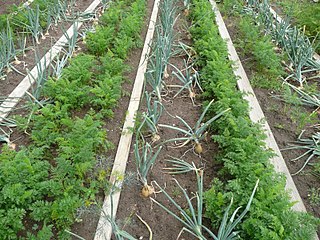
Gardening is the practice of growing and cultivating plants as part of horticulture. In gardens, ornamental plants are often grown for their flowers, foliage, or overall appearance; useful plants, such as root vegetables, leaf vegetables, fruits, and herbs, are grown for consumption, for use as dyes, or for medicinal or cosmetic use. Gardening is considered by many people to be a relaxing activity.

Raised-bed gardening is a form of gardening in which the soil is enclosed in three-to-four-foot-wide (1.0–1.2 m) containment units ("beds"), which are usually made of wood, rock, or concrete and which can be of any length or shape. The soil is raised above the surrounding soil and may be enriched with compost.

A garden is a planned space, usually outdoors, set aside for the display, cultivation, or enjoyment of plants and other forms of nature. The garden can incorporate both natural and man-made materials. The most common form today is a residential garden, but the term garden has traditionally been a more general one. Zoos, which display wild animals in simulated natural habitats, were formerly called zoological gardens. Western gardens are almost universally based on plants, with garden often signifying a shortened form of botanical garden. Some traditional types of eastern gardens, such as Zen gardens, use plants sparsely or not at all.

Robert Adrian de Jauralde Hart was an English pioneer of forest gardening in temperate zones. He created a model forest garden from a 0.12 acre (500 m²) orchard on his farm. He credits the inspiration for his work to an article by James Sholto Douglas, which was in turn inspired by the work of Toyohiko Kagawa.(page 41)

The history of gardening may be considered as aesthetic expressions of beauty through art and nature, a display of taste or style in civilized life, an expression of an individual's or culture's philosophy, and sometimes as a display of private status or national pride—in private and public landscapes.

Victory gardens, also called war gardens or food gardens for defense, were vegetable, fruit, and herb gardens planted at private residences and public parks in the United States, United Kingdom, Canada, Australia and Germany during World War I and World War II. In the war time governments encouraged people to plant victory gardens not only to supplement their rations but also to boost morale. George Washington Carver wrote an agricultural tract and promoted the idea of what he called a "Victory Garden". They were used along with Rationing Stamps and Cards to reduce pressure on the public food supply. Besides indirectly aiding the war effort, these gardens were also considered a civil "morale booster" in that gardeners could feel empowered by their contribution of labor and rewarded by the produce grown. This made victory gardens a part of daily life on the home front.

Garden design is the art and process of designing and creating plans for layout and planting of gardens and landscapes. Garden design may be done by the garden owner themselves, or by professionals of varying levels of experience and expertise. Most professional garden designers have some training in horticulture and the principles of design. Some are also landscape architects, a more formal level of training that usually requires an advanced degree and often a state license. Amateur gardeners may also attain a high level of experience from extensive hours working in their own gardens, through casual study, serious study in Master Gardener Programs, or by joining gardening clubs.

The cottage garden is a distinct style that uses informal design, traditional materials, dense plantings, and a mixture of ornamental and edible plants. English in origin, it depends on grace and charm rather than grandeur and formal structure. Homely and functional gardens connected to working-class cottages go back centuries, but their stylized reinvention occurred in 1870s England, as a reaction to the more structured, rigorously maintained estate gardens with their formal designs and mass plantings of greenhouse annuals.

The Reeves-Reed Arboretum is a nonprofit arboretum and garden located at 165 Hobart Avenue in Summit, Union County, New Jersey, United States. It is the only arboretum in Union County. A popular wedding spot, the arboretum grounds are open daily from dawn till dusk, free of charge.

The George Griswold Frelinghuysen Arboretum is an arboretum located at 353 East Hanover Avenue, Morris Township, New Jersey. It is open daily without charge. It is also the headquarters of the Morris County Parks Commission.
This is an alphabetical index of articles related to gardening.

Kailyard redirects here. For the grouping of Scottish literature see Kailyard school
A monastic garden was used by many and for multiple purposes. In many ways, gardening was the chief method of providing food for households, but also encompassed orchards, cemeteries and pleasure gardens, as well as medicinal and cultural uses. Gardening is the deliberate cultivation of plants herbs, fruits, flowers, or vegetables.
The West Side Community Garden is a privately owned park in Manhattan, New York City, United States. It is located between West 89th Street and West 90th Street in the middle of the block between Amsterdam Avenue and Columbus Avenue.

The Gardens of Monticello were gardens first designed by Thomas Jefferson for his plantation Monticello near Charlottesville, Virginia. Jefferson's detailed historical accounts of his 5,000 acres provide much information about the ever-changing contents of the gardens. The areas included a flower garden, a fruit orchard, and a vegetable garden. Jefferson, a connoisseur of trees, flowers, and gardening techniques, was highly interested in experimental planting and directed the design of the gardens, which contained many exotic seeds and plants from his travels abroad.
Dr. John de Sequeyra was born into a Spanish-Portuguese Jewish family whose ancestors were once court physicians to the Kings and Queens of Spain and Portugal. He was the middle son of Dr. Abraham de Sequeira (1665-1747) who was a member of Bevis Marks Synagogue in London.
Gardening Naturally was a TV show series hosted by Barbara Damrosch and Eliot Coleman. It was created from 1993 to 1994 and ran until about 2003. It first aired on TLC and later reruns were shown on Discovery Home and Leisure.

Gardening in Scotland, the design of planned spaces set aside for the display, cultivation, and enjoyment of plants and other forms of nature began in the Middle Ages.
Ina Grace Tabor was an American pioneering landscape architect and designer, writer and editor. She was one of the first women to identify herself professionally as landscape architect. She is best known as the author on the subjects of landscape design and horticulture. She is the author of ten garden books, most of which were published between 1910 and 1921.














